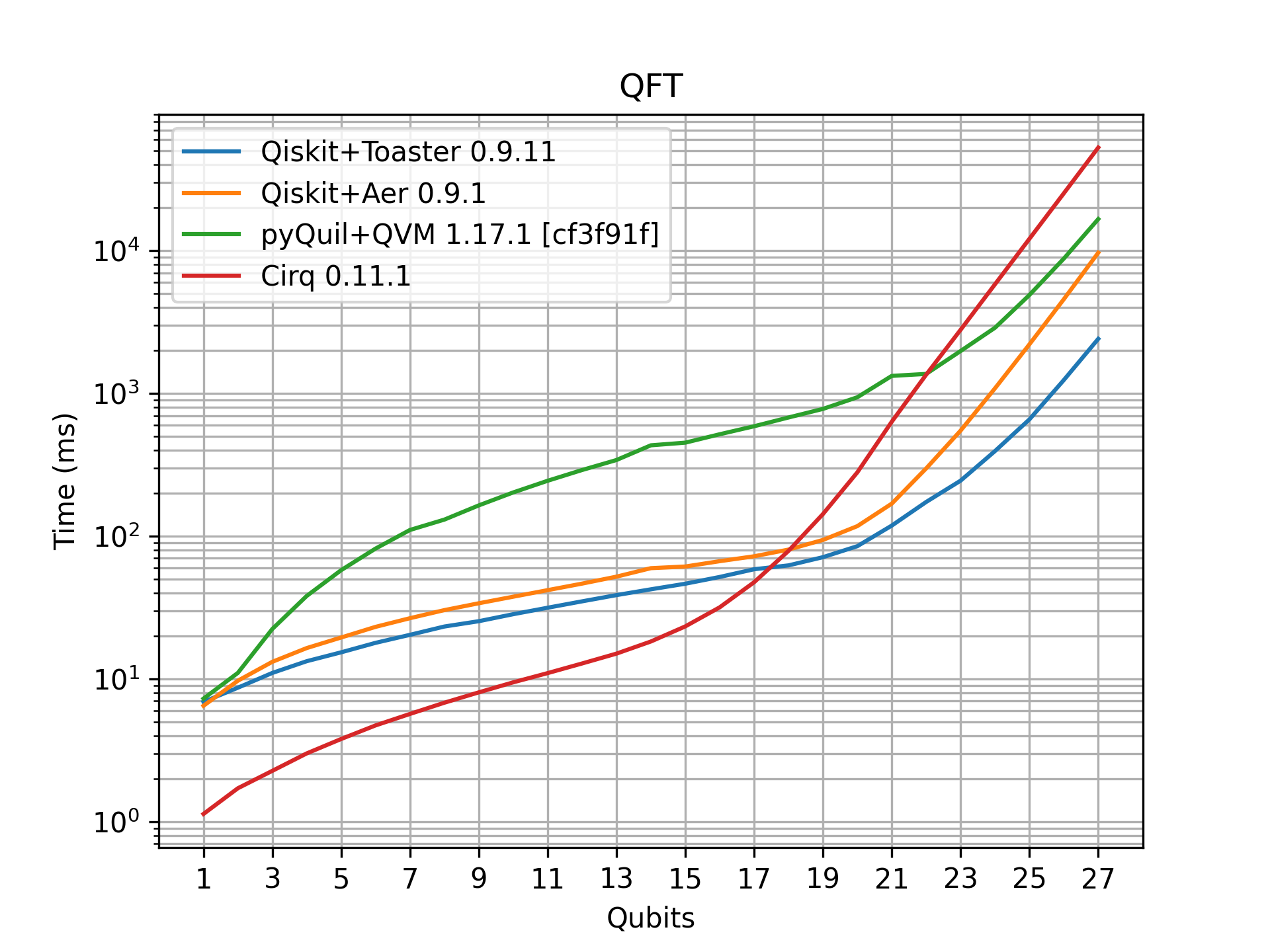A high performance quantum circuit simulator
A high performance quantum circuit simulator
The Qubit Toaster is a high performance quantum circuit simulator designed for speed. It is based on our original algorithms for circuit optimization and efficient execution. Can be used stand-alone or as a replacement in popular quantum programming frameworks.

More benchmarks comming soon. You can help by contributing code to Quantum Simulator Benchmark repository. More simulators and more algorithms are welcome.
Qubit Toaster is shipped as a precompiled binary for Linux, MacOS and Windows, and can be installed in two ways:
Install directly on your local machine
Fetch and run pre-configured Docker container
To install on your local machine, open your terminal and execute following command:
curl https://quantastica.com/toaster/install | /bin/sh
The script will download and extract binaries into ~/.qubit-toaster/ directory. Sript will then try to make symlink in /usr/local/bin/. Creating symlink requires sudo permissions, so if you are installing as non-privileged user, you will be asked to enter your sudo password. This is not mandatory - if you skip creating symlink then qubit-toaster will not be globally accessible from terminal, but you will be able to run it by providing full path to the executable. You can also create symlink manually after the installation.
Please download and run windows installer: Qubit-Toaster-Installer.exe
If you are uncomfortable with running pre-compiled binary directly on your system, you can run Qubit Toaster in a Docker container.
docker pull quantastica/qubit-toaster:latest
docker run -d -p 127.0.0.1:8001:8001 --restart=always --name qubit-toaster quantastica/qubit-toaster:latest
Inside container, qubit toaster is running as a server and is listening for http requests on port 8001.
Qubit Toaster can run in two modes:
Server mode
Command line tool
When running in server mode, it can be used as a replacement simulator in Qiskit and other popular quantum programming frameworks (backends for pyQuil and Cirq coming soon).
If are running a pre-configured Docker container then Qubit Toaster is already started in server mode inside container and is listening on (default) port 8001.
If you installed the toaster on a "bare metal", then simply run following command:
qubit-toaster -S
When executed as a command line tool, it expects quantum circuit in json format (from file or directly from stdin) and after execution it prints simulation results to stdout.
Input file can be generated automatically from IBM's QASM or from Rigetti's QUIL code by using qconvert command line utility, or Web based online converter.
qubit-toaster -s 1024 -r counts bell_state.json
{
"qtoaster_version": "0.9.10",
"error_code": 0,
"message": "",
"counts": { "00": 518, "11": 506},
"time_taken": "0.000159"
}
If you wish to get state vector then use -r state option:
qubit-toaster -s 1024 -r counts -r state bell_state.json
{
"qtoaster_version": "0.9.10",
"error_code": 0,
"message": "",
"counts": { "00": 515, "11": 509 },
"statevector": [ [0.707106781186545, 0], [0, 0], [0, 0], [0.707106781186545, 0] ],
"time_taken": "0.000248"
}
Qubit toaster is QASM 2.0 compatible, so it supports classical registers and classicaly controlled quantum gates.
For more options type:
qubit-toaster --help
In order to use the Qubit Toaster instead of Aer simulators in your Qiskit experiments, make sure that toaster is running in server mode and do following:
pip install quantastica-qiskit-toaster
from quantastica.qiskit_toaster import ToasterBackend
And then instead:
backend = Aer.get_backend("qasm_simulator")
Use:
backend = ToasterBackend.get_backend("qasm_simulator")
Toaster can be used instead Aer's statevector simulator as well:
backend = ToasterBackend.get_backend("statevector_simulator")
Simple as that.
For more details, please see quantastica-qiskit-toaster package's README.
Quantum Programming Studio can run simulations directly on your locally installed Qubit Toaster. Please see QPS Client Docs for more information.
Submits json payload to qubit-toaster for execution, parameters are passed via HTTP headers.
Content-Type : must be application/json
Content-Length : size of payload
x-qtc-seed (integer) Number (uint32) used for overriding default random number generator seed value
x-qtc-shots (integer) Number of repetitions
x-qtc-optimization (integer) Optimization level (0 - automatic, 1 - off, 2.. - use given optimization level)
x-qtc-return (string) What to return? Can be one or more of the following:
counts (default)
measure_all
probabilities
registers
state
x-qtc-no-wait (0 or 1) If this parameter is set to 1 the server will close HTTP request right after it is completely read, to get results client needs to use GET /getresult or GET /pollresult endpoints
x-qtc-jobid (string) jobid that will be used for querying result of this simulation (not needed if you are sure that this request will not timeout)
Returns (immediately) result (as application/json) or one of following HTTP status codes:
202 - given job is not processed yet
404 - job with that id is not found
If given job is processed returns immediately, otherwise waits until it is processed. If job with give jobid is not found API returns 404 HTTP status code
Returns info in json format containing following values:
version - toaster's version
queue_size - queue size
available - number available slots in queue
unread - number of jobs that are processed but their result is not read yet
201 Queued
202 Not Processed Yet
400 Bad Request
404 Not Found
409 Jobid Conflict
413 Payload Too Large
415 Unsupported Media Type
422 Unprocessable Entity
429 Too Many Requests
431 Request Header Fields Too Large
499 Generic Error
-H "Expect:" is used in following examples to prevent curl from sending Expect:100 Continue request first.
qubit-toaster should be listening on default port (8001), to see debug info you can pass debug level like following:
qubit-toaster -S -l info
curl -H "Expect:" --header "Content-Type: application/json" --data-binary @examples/adder.json http://localhost:8001/submit
curl -H "Expect:" --header "Content-Type: application/json" --data-binary @examples/bell.json -H "x-qtc-seed: 2" -H "x-qtc-shots:16" -H "x-qtc-optimization:7" -H "x-qtc-return:measure_all" http://localhost:8001/submit
Please note that if you execute following requests multiple times on same instance of toaster the submit request (first one) will fail with 409 Jobid Conflict status
curl -v -H "Expect:" --header "Content-Type: application/json" --data-binary @examples/qft25.json -H "x-qtc-seed: 2" -H "x-qtc-shots:16" -H "x-qtc-optimization:7" -H "x-qtc-return:measure_all" -H "x-qtc-jobid:1234567" -H "x-qtc-no-wait:1" http://localhost:8001/submit
curl http://localhost:8001/info
curl -v http://localhost:8001/getresult/1234567
curl -v http://localhost:8001/pollresult/1234567
Lapinlahdenkatu 16 C, 00180 Helsinki, Finland, EU